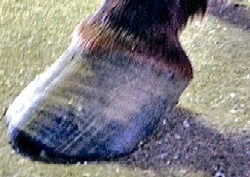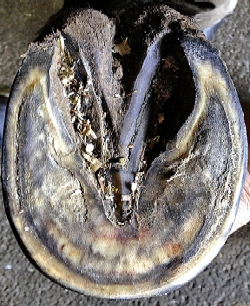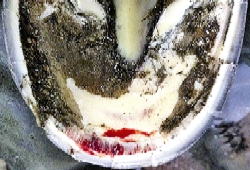Over the years I’ve heard many comments about long toes on racehorses. Horses that knuckle over behind were said to have “long toe-itis.” Many trotters that are doing well “don’t need any toe to trot,” trainers say.
 (Photos by the author) Fig. 1
(Photos by the author) Fig. 1
What people mean is that most horses do better without the detriment of a long toe or delayed break-over. I’ve already discussed what it does to the gait in another article, but found a great example of the stress this can place upon the hoof on a broodmare.
Broodmares stress feet in different ways than racehorses, but not necessarily less. They stress feet through the burden of extra weight. When a horse’s weight is increased significantly--in this case by a pregnancy--it can negatively affect hoof soundness.
When mares get long toes (Fig. 1), problems may occur. By having a strong hoof wall—which is typical with Standardbreds--she had not broken up her feet and appeared to be fine. When she walked up, I noticed she was a little gimpy on the turns and asked if this had been going on for long. The answer was that she had been mildly sore on and off for about 10 days.
When I trimmed her feet it revealed the reason (Fig. 2). The excessive toe length created stress in the front of her hooves. While this was not laminitis, I still regard hemorrhaging in the laminar region as very serious and possibly leading into permanent problems. The hoof in Fig. 2 appears to be actively bleeding, when in fact the hemorrhaging had already occurred and was just lying in the hoof. This in itself can cause trouble.
 Fig. 2
Fig. 2
We trimmed this mare and rasped back the forward distortion of the dorsal (front) hoof wall. Three weeks later, we trimmed her again and found the feet in much better shape (Fig. 3). She was also sound all the time at this point. Having caught this mare so soon after the bleeding occurred (evident by the fresh color of the blood), we probably avoided the complications of that blood staying there or even increasing through further hemorrhaging. Incidentally, all four feet were affected; Fig. 4 was the worst foot during the first trimming.
 Fig. 3
Fig. 3
Abscesses, acute lameness or both were very possible. If this were to happen in the late stages of pregnancy, it could affect the foaling. If mares are in late pregnancy and their hooves look to be in bad shape, I do not recommend trying to fix it by trimming a lot of hoof away. Just ask your farrier to give her a light trim until after foaling and then bring those feet back into form. Trimming the feet very short on heavy, late-pregnancy mares can be disastrous, so use caution in that stage of pregnancy. It takes a long time for feet to get that far out of shape, so don’t try to fix it all at once. This is why we trimmed this mare twice in three weeks.
For a fit racehorse, long toes create different problems, including heel bruises, interference and gait issues. These horses are amazing athletes and handle a great many adversities incredibly well. For a heavy, aging broodmare, the consequences can be much more profound and the lamenting comments of the people involved with that cannot be repeated in a public forum. This does not mean a farm should trim mares every three weeks; in fact, that kind of frequency is almost never needed.
 Fig. 4
Fig. 4
Growth rates of hooves change in different times of the year. They grow fast in a warm, wet spring, and slow in a dry, hot summer or an extremely cold winter. Just watching and adjusting to those growth rates is all that is needed. Turning a blind eye to bad looking feet on the mares could bring on trouble. If those hooves look too long to your eye, they probably are.
As Ben Franklin said, “an ounce of prevention is worth a pound of cure.” This is especially true when your broodmare has all those pounds.
Veteran Standardbred farrier Steve Stanley of Lexington, Ky., authors a monthly column for Hoof Beats, the official harness racing publication of the U.S. Trotting Association. The American Farriers Journal Editorial Advisory Board member offers plenty of practical advice that will be of special interest regardless of the type of horses that you work with. Click here to read more from Steve Stanley's Hoof Beats series.








Post a comment
Report Abusive Comment